Squash is a fruit (well I called it a vegetable as a child) that brings back so many family memories of mealtimes, cooking and special occasions, but also harvesting them from the garden with much delight and satisfaction.
Let's talk more about squash, its different types, and how to grow squash in Australia.
More...
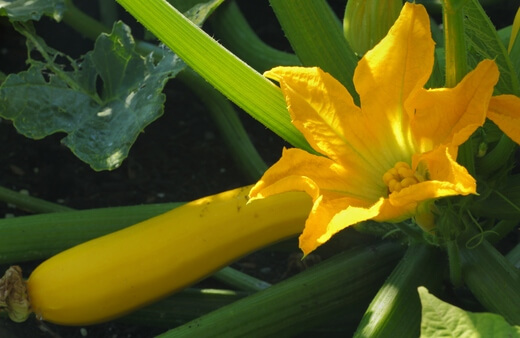
Family: | Cucurbitaceae |
|---|---|
Genus: | Cucurbita |
Common Names: | Yellow squash, Summer squash |
Origin: | Central America and Mexico |
Location: | Outdoor |
Type: | Herbaceous fruit |
Growth: | Up to 60 cm tall, 1.2 metres wide |
Sun requirements: | Full sun |
Foliage Colour: | Green and sometimes speckled |
Flower Colour: | Yellow and orange |
Flowering: | End of spring to early autumn |
Fruit: | Mild, slightly sweet and grassy |
Maintenance level: | Average |
Poisonous for pets: | No |
Introducing Summer Squash
The focus of our article is summer squash and these are usually harvested when the skin is still soft and can be eaten. Summer squash usually grow quite bushy compared to winter squashes which grow on long vines. They also have a shorter storage life compared to the winter ones.
Different Kinds of Summer Squashes
Cousa squashThese have a pale colour and are much like a zucchini variety. They are said to originate from the Middle East or West Asia. They have an oval shape and are sweeter than zucchini. | 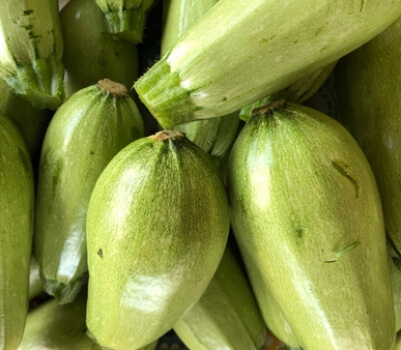 |
Pattypan squash or scallop squashThis squash is small and flat with scalloped edges. The flavour is sweet and similar to a yellow squash but its texture is firmer. |  |
Tromboncino or zucchettaIt has a small to medium size and is a cylinder shape. The taste is mild and nutty with some sweet notes. It is a type of climbing zucchini. |  |
Crookneck squashA variety of yellow squash. The bottom is more round and the neck of the fruit is more slender and is also curved at the top. It has big seeds and the skin is thicker and waxier compared to some other types of squash. | 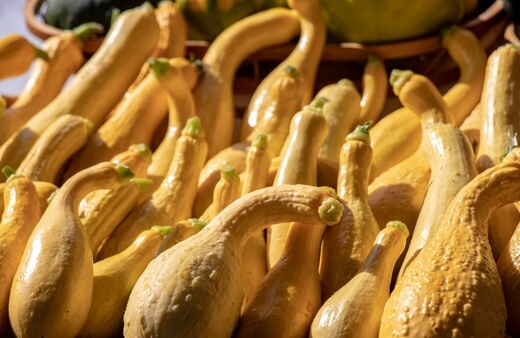 |
Straightneck squashA variety of yellow squash that has a mild and sweet taste with quite watery flesh. The fruits are straight and yellow. | 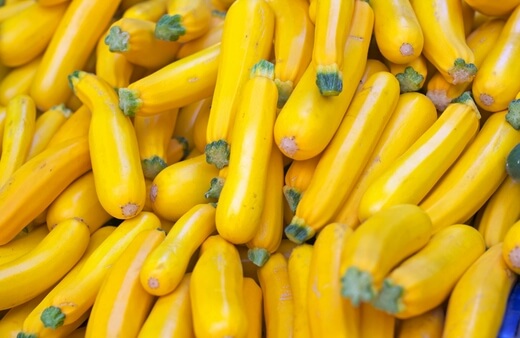 |
Zucchini (courgette) and baby marrowUsually different shades of green but you do get a golden zucchini which can be yellow or orange. If left to completely mature they could grow up to a metre in length but are usually harvested when they’re much smaller. |  |
Cousa squash

These have a pale colour and are much like a zucchini variety. They are said to originate from the Middle East or West Asia. They have an oval shape and are sweeter than zucchini.
Pattypan squash or scallop squash

This squash is small and flat with scalloped edges. The flavour is sweet and similar to a yellow squash but its texture is firmer.
Tromboncino or zucchetta

It has a small to medium size and is a cylinder shape. The taste is mild and nutty with some sweet notes. It is a type of climbing zucchini.
Crookneck squash

A variety of yellow squash. The bottom is more round and the neck of the fruit is more slender and is also curved at the top. It has big seeds and the skin is thicker and waxier compared to some other types of squash.
Straightneck squash

A variety of yellow squash that has a mild and sweet taste with quite watery flesh. The fruits are straight and yellow.
Zucchini (courgette) and baby marrow

Usually different shades of green but you do get a golden zucchini which can be yellow or orange. If left to completely mature they could grow up to a metre in length but are usually harvested when they’re much smaller.
How to Grow Squash in Australia
Propagating Squash
You can easily grow your own squash from seed. Once you have harvested the seed from an existing squash, you can soak the seed overnight and then plant between 3 to 6 seeds together. When the seeds have begun to sprout, identify those that seem the most strong and get rid of the rest.
When you start to see a set of leaves on the seedling, we recommend mulching the soil to help lock in moisture but be sure it doesn’t touch the stems otherwise it might cause them to rot.
How to Care for Squash
Sunlight
Squash are in need of full sun in order to produce their fruit. This means you’re aiming for at least 6 hours of sunlight each day. If you find that the weather is very hot for long periods of time, the plant might become stressed and you would need to look at creating some shade.
Soil
Squash are happiest in a soil that is slightly acidic and you can aim for a pH between 6 and 6.8. If you have soil that is too acidic, you can add lime to balance it out. Squash are hungry for nutrients so try and provide a soil that has plenty of organic matter.
If you are transplanting seedlings into the soil, you can add a cup of organic fertiliser when you do. Fertile and well-draining soil will produce quality fruit and keep your squash happy. In the case of planting seeds, you can incorporate the fertiliser into the top layer of soil.


Get Your Free Guide:
Master Growing Australian Natives eBook
A Must Have Complete Guide for Every Australian Garden
Get Your Free Guide:
Master Growing Australian Natives eBook
A Must Have Complete Guide for Every Australian Garden
Watering Squash
Squash needs sufficient moisture and you can aim to water a mature squash once per week. If your plant is growing in sandy soil or the weather is very hot, you can then water more often.
Harvesting and Storing Squash

When it comes to harvesting your squash plant, you should keep an eye on them and do daily checks as they develop quickly. The more you harvest, the more the plant will produce and we recommend picking the fruits when they are small.
A squash that is over ripe doesn’t have much flavour. They also become hard and seedy. Summer squash varieties should be harvested before the seeds have had a chance to become fully ripe and the rind should be soft.
You are able to store summer squash somewhere that is cool and moist for up to two weeks. You can also freeze them. Summer squash is absolutely delicious used in a salad, added to stir fry, or as a component in other dishes.
Patty pan squash in particular, is a type of summer squash that is well-known for its round shape and patterned edges. It’s also sometimes called a scallop squash, custard squash, or button squash, but in Australian English, it’s usually just called “squash’.
The Patty pan squash actually comes in many different colours and there are even multi colour varieties. It’s sometimes used in fine dining to present a kind of flavoured stuffing that fills the Patty pan.
This type of summer squash is high in magnesium, vitamins A and C, and are a low calorie food. They can be enjoyed coated and fried or just boiled.
How to Harvest Squash
When harvesting your squash, be sure to cut it from the plant using a clean and sharp secateurs and be sure to leave a bit of stem still attached to the squash. The stem actually protects the squash from rotting and will help it keep for longer when you store it.
Curing Squash
Squash grown at home can last for a really long time but you will need to cure them first. You can do this by leaving the squash outdoors in the sun after it has been harvested for around 7 to 10 days.
The weather should ideally be warm and dry. If you are living somewhere that is prone to frost and colder weather, you can also cure squash in a window that is warm and sunny for up to 10 days.
How to Store Squash
Once you have cured your squash for storage purposes, you can then place it somewhere that gets good ventilation and that maintains a temperature between 10 and 12°C. Humidity should be comfortable as well.
Try and store your squashes in a single layer and they shouldn’t be touching each other. Different types of squash can be kept for different time periods. You’ll need to check your squash often for soft spots or any signs of rot, and be sure to rotate often.
Common Squash Pests and Diseases
Aphids
Aphids are tiny and have soft bodies. They can appear in many different colours including green, yellow, red or black. The most common place to find them on your plant would be on any new growth or in the creases of the leaves.
Some of the markers that your squash is under attack from aphids could be leaves that become mottled and yellow but also leaves that are curling and brown. You might also notice that the growth of your plant seems to be affected.
The aphids literally suck the life out of your plant but they also spread disease. It’s a good idea to check your plants often for the presence of aphids to try and catch them early before an aphid infestation gets out of hand.
If you can encourage predator insects like ladybirds, this can also help keep the pest under control. For a small infestation, using a strong spray of water can knock the aphids loose.
Cucumber mosaic virus
If your squash is under attack from cucumber mosaic virus, the leaves of the plant start to become brittle and you’ll see patches of yellow and darker shades of green. Any edible parts of the plant might have some puckering and don’t form properly. The taste would also be bitter.
This virus affects the plant by confusing the genetic development and processes. Leaves that are affected by the virus are disrupted from normal function. That means your squash plant won’t be able to grow as it needs to and it won’t increase in size. The yellow patches on the leaves start to become brown as the virus infection gets more advanced.
It’s worth noting that if you manage to get aphids under control in your garden, it also minimises the risk for diseases like cucumber mosaic virus. If you grow an abundance of flowers that produce nectar, they will attract things like ladybirds to eat up the aphids.
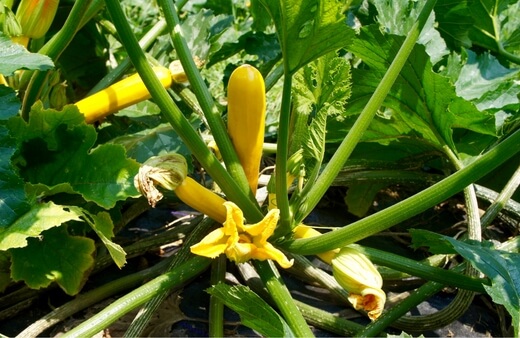
Squash downy mildew
This disease is usually triggered after cold and wet weather. You might notice the first symptoms of the disease on the leaves which are a type of yellow spot and underneath the spots, develops a furry type of purple mould.
Squash downy mildew thrives best when the temperature is between 15 and 20°C. In some cases, your squash plant could lose up to a third of its leaves and will struggle to produce adequately.
A good way to help protect your plant is to ensure it gets enough air circulation and sun. Keep weeds well under control and mulch the soil to avoid splashing onto plants during rainy weather.
If you are watering from overhead and the weather is cool, just be aware that this could trigger the disease. If you notice any infected leaves, you can prune these off accordingly and then we recommend spraying the plant with a mixture of 1 litre of water with a teaspoon of baking soda.
Squash powdery mildew
The easiest way to identify this disease is when you see white floury looking markings on the top of the leaves. As the disease progresses, the leaves might start becoming a greyer green colour and they feel dry.
The leaves will then become brown and fall off. This type of powdery mildew has a tendency to attack plants that are older and it enjoys warmer weather, ideally between 21 and 27°C.
Squash powdery mildew operates by clogging up the pores in the leaves which doesn’t allow light into the cells. This means they don’t have sufficient energy to thrive. Any new growth can’t take place and the plant will start to die.
When planting your squash, it’s recommended to space them properly to allow for sufficient sun and air circulation. You can also make a spray that is one part milk to four parts water, and then spray your plant every 10 days at the start of summer.
Squash Frequently Asked Questions
What is the difference between summer and winter squash?
Squash is essentially one of two different kinds – summer and winter squash. Summer squash grows quickly, within about 60 days, and the ideal time to harvest is during summer when the fruit is young. The skin of the squash is soft and thin.
Winter squash takes a bit longer to grow and they change into a bright colour before they are harvested. The skin is thicker which means you can store them for longer.
What is the history of squash?
Squash is a food source that dates back to 8000 B.C, and there is evidence to show its use in Mexico, Peru, and parts of the United States as far back as this date.
Where does the name squash come from?
The name originates from the Narragansett Indian word “askutasquash”. It means to eat raw or uncooked.
Get inspired with more plants and fruits for your garden. Sign up for our newsletter.Wrapping Up Our Squash Growing Guide
Squash is one of those hearty and wholesome foods that can be enjoyed in so many different ways all year round. Growing your own at home is super easy, from propagation to storage. We are giving summer squash our green thumbs up!
Published on March 20, 2023 by Maisie Blevins
Last Updated on February 25, 2025




